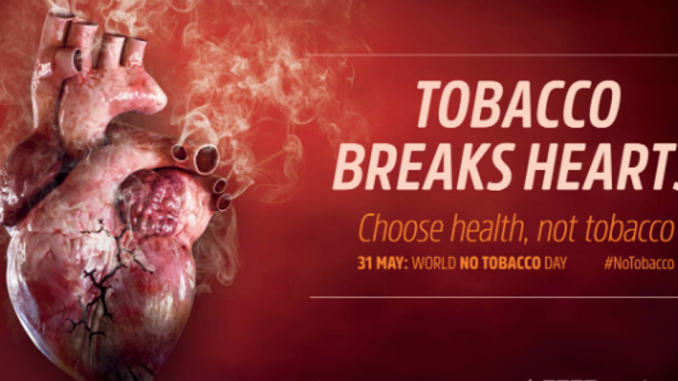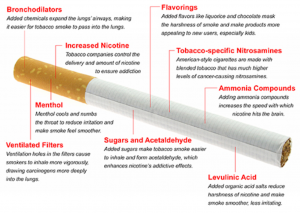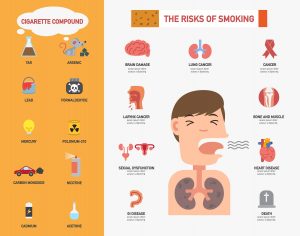
Table of Contents
What is Tobacco?
- Basically, tobacco is a plant.
- Tobacco leaves are dried, fermented and used as a tobacco product.
- Tobacco contains nicotine, a constituent responsible for the addiction among people (which is the reason people find it difficult to quit).
Key Facts on Tobacco:
- According to WHO, tobacco kills up to half of its users.
- Tobacco consumption is the leading preventable cause of death
- Tobacco epidemic is one of the biggest public health threats in the world.
- Tobacco kills more than 8 million people each year. Among those 8 million people, more than 7 million deaths are due to direct use of tobacco while the other 1.2 million deaths are the deaths of non-smokers being exposed to second-hand smoking.
- Low- and middle-income countries constitute of around 80% of the world’s 1.1 billion smokers.
- Smoking causes more deaths each year than the following causes combined:
- Human immunodeficiency virus (HIV)
- Illegal drug use
- Alcohol use
- Motor vehicle injuries
- Firearm-related incidents
- In 2017, tobacco killed 3.3 million users and people exposed to second-hand smoke from lung-related conditions, including:
- 5 million people dying from chronic respiratory diseases
- 2 million deaths from cancer (tracheal, bronchus and lung cancer)
- 600,000 deaths from respiratory infections and tuberculosis
- More than 60,000 children aged under five die of lower respiratory infections caused by second-hand smoke. Those who live on into adulthood are more likely to develop the chronic obstructive pulmonary disease (COPD) later in life.
Types of Tobacco:
There are mainly two different types of tobacco:
1. Smoking tobacco:
-
- Cigarette
- Biri
- Hukka
- Cigar
- Pipe

2. Smokeless tobacco:
-
- Chewing tobacco
- Snuff
Factors Contributing to Tobacco Use:
The choice to use and continue to use a tobacco product depends on many factors:
- Personal factors such as self-image
- Societal factors such as easy access to cigarettes and tobacco products
- Family environment where family members are smokers/tobacco users
- Peer pressure
- Attractive advertisement and promotion
- Magazine advertisements
- Outdoor advertisements
- In-Store promotions
- Racial/ethnic symbols, names, and events
- Targeted products
- Psycho-social determinants
- Economic influences
- Tobacco industry support for racial/ethnic minority communities
- The tobacco industry’s longtime economic support for U.S. racial/ethnic communities may have contributed to the survival of many of these communities’ institutions.
- For example, the tobacco industry supports African American communities in five main ways:
- Direct employment of African Americans
- Support for social services and civil rights organizations
- Contributions to politicians and political organizations
- Support for educational and cultural programs
- Contracts with small businesses
Incentives Provided by Tobacco Industries to Attract People:
Apart from various economic influences created by the tobacco industries, other form of incentives provided by the tobacco industries are:
a) Employment Opportunities
- Many of the tobacco industry has been creating employment opportunities to the marginalized to high standard level people in expanding country’s economy.
b) Advertising Revenues
- By placing advertisements in racial/ethnic publications, primarily those with limited circulations, tobacco companies have become important contributors to advertising revenues for these publications.
c) Funding for Community Agencies and Organizations
- The tobacco product and alcoholic beverage industries have made significant financial and in-kind contributions to various racial/ethnic community organizations at the local, regional, and national levels.
- These contributions have at times been described as marriages of convenience in which community organizations, agencies receive much-needed income, and tobacco companies gain, at a minimum, name recognition and goodwill.
d) Support for Education
- For years, the tobacco industry has contributed to programs that aim to enhance the primary and secondary education of children, has funded universities and colleges, and has supported scholarship programs targeting African Americans (the UNCF) and Hispanics (the National Hispanic Scholarship Fund).
e) Support for Political, Civic, and Community Campaigns
f) Support for Cultural Activities
- Tobacco companies have also supported different cultural events in order to reach among all members and groups of the society. Tobacco companies sponsor large museum exhibitions, concerts, and performances for the full spectrum of society.
g) Support for Sports Events
- Tobacco companies have maintained a link to sports and racial/ethnic communities through such means as sponsoring the Jackie Robinson Foundation Awards Dinner.
Adverse Effects of Tobacco:
a) Increased Health Risks
- Heart disease
- Stroke
- Lung cancer
- Increase in Health utilization cost
- Increase Absenteeism from work
- Low functioning
- Hampers overall healthy life

b) Cancer
- Bladder
- Blood (acute myeloid leukemia)
- Cervix
- Colon and rectum (colorectal)
- Esophagus
- Kidney and ureter
- Larynx
- Liver
- Oropharynx (includes parts of the throat, tongue, soft palate, and the tonsils)
- Pancreas
- Stomach
- Trachea, bronchus, and lung
c) Other Health Risks
- Preterm delivery
- Stillbirth
- Low birth weight
- Sudden infant death syndrome
- Ectopic pregnancy
- Orofacial clefts in infants
- Smoking can also affect men’s sperm, which can reduce fertility and increase risks for birth defects and miscarriage.
- Smoking can affect bone health.
- Women past childbearing years who smoke have weaker bones than women who has never smoked. They are also at greater risk for broken bones.
- Smoking affects the oral health i.e. health of your teeth and gums. It can ultimately result in tooth loss.
- Smoking can increase your risk of cataracts.
- Smoking can also cause age-related macular degeneration (AMD). AMD is damage to a small spot near the center of the retina, the part of the eye needed for central vision.
- Smoking is one of the major factors for causing type 2 diabetes mellitus. The risk of developing diabetes is 30–40% higher for active smokers than nonsmokers.
- Smoking also increases the risk of rheumatoid arthritis.
- Apart from these effects, smoking causes general adverse effects on the body, including inflammation and decreased immune function.
Preventive Measures:
- Awareness and sensitization
- Bans on tobacco advertising and sponsorship
- Pictorial health warnings on tobacco products
- Supporting tobacco users to quit smoking and use tobacco products
- Standardized and systematic surveillance, especially targeting youths and adults to understand the nature of tobacco use
- Strong political commitment to reduce the use of tobacco products
- Increase in taxes on tobacco products
Prevention Measures Targeting the Youths:
- School based curriculum
- Parental involvement
- Teen cessation programs
- Mass media campaigns
- Ban of advertising and promotions nearby school and college areas
WHO’s MPOWER Package:
WHO has developed MPOWER package to fight against tobacco epidemic and its effect. Each MPOWER links with at least 1 provision of the WHO Framework Convention on Tobacco Control (FCTC):
The 6 MPOWER measures are:
- Monitor tobacco use and prevention policies
- Protect people from tobacco use
- Offer help to quit tobacco use
- Warn about the dangers of tobacco
- Enforce bans on tobacco advertising, promotion and sponsorship
- Raise taxes on tobacco
References and For More Information:
https://www.who.int/news-room/fact-sheets/detail/tobacco
https://www.cdc.gov/tobacco/data_statistics/fact_sheets/health_effects/effects_cig_smoking/index.htm
https://www.cdc.gov/tobacco/data_statistics/sgr/1998/complete_report/pdfs/chap4.pdf
https://www.sciencedirect.com/science/article/pii/S0954611106003520
https://www.livestrong.com/article/77788-factors-influence-people-smoke/
https://www.cdc.gov/tobacco/data_statistics/fact_sheets/health_effects/effects_cig_smoking/index.htm
https://www.ncbi.nlm.nih.gov/books/NBK215329/
https://www.drugabuse.gov/publications/drugfacts/cigarettes-other-tobacco-products
https://www.who.int/news-room/fact-sheets/detail/tobacco
https://www.cdc.gov/tobacco/data_statistics/fact_sheets/index.htm
https://www.cdc.gov/tobacco/disparities/low-ses/index.htm